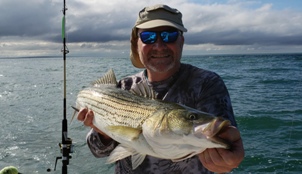Strategic fishing by understanding basic fish biology

Capt. Todd MacGregor, MAC-ATAC Sportfishing, Fairhaven, MA
Although I consider myself the eternal optimist, especially when it comes to fishing, I learned a long time ago that there is almost no luck in fishing; especially Striper and Tuna fishing. With almost 40 years experience fishing, 27 years as a licensed Captain, and growing up around my Dad, Captain Bob MacGregor of the HOP-TUIT, and the many great Cuttyhunk Guides, I learned that timing is everything and you must use the proper timing to your advantage. If you understand proper timing, all you need is the availability of fish and decent weather conditions.
As I am writing this article, I am also in the process of booking many returning charter clients. They all know that we will either leave in the early morning and fish really hard until 7 or 8 AM or leave in the evening or after dark and fish hard until 1 or 2 AM. There is no substitute for effort. As I book the charters, I am planning for the fishing to be terrible and making sure we do everything to give ourselves the decided advantage. I take nothing for granted. This keeps me working hard and gives my customers the best opportunity for success. Even when the fishing is slow, we pick at them throughout the trip and the trip generally turns out well.
Fish, especially larger fish, are very affected by light. Fish will generally seek their optimal level of light. This explains why larger fish are in the shallows at night and go deeper in the daytime. Since we know that fish are cold blooded animals that cannot think and simply react to their environment, we also know that the shallow waters are warmer and thus the fish’s metabolism is stimulated when they move towards the shallows at dusk. The converse is true during the daylight when they move to deeper waters. Unless there are a billion fish around and tons of bait to stimulate them, I rarely feel confident that I will crush the fish in the daytime around the Elizabeth islands. I can take an afternoon charter and may get 15-20 bass, mostly schoolies, with the largest maybe in the low 20 lb range. But, at night, the fish are much more active and the average fish is in the 30 lb. range with many 40-50 lbs fish taken on the trolled Danny and Gibbs plugs every spring.
When I say that timing is everything, we have to understand that fish do not eat all of the time. They simply can’t and if they did, they would all be 500 lbs. Fish tend to eat in 2 – 4 movements per day. Dawn, Dusk and the change of the tides or when it just starts moving and before it is running hard. When the fishing stinks, I always fish dawn and dusk to produce a few fish. When the fishing is better, the false dawn time (in the spring from 3:45 – 4:30 AM) will provide the best fishing and it will peter out as the day gets brighter. When the tides coincide with dusk on the Sow and Pigs Reef or the Devil’s Bridge (conditions permitting), I can be pretty sure we will do well. Typically we pick at smaller fish on the jigs until dark and then all hell breaks loose at 8:45 PM. I call this the “witching hour” in the spring and early summer. I can very often watch the fish rush in from the deeper water on the depth machine. This is the time for the white Danny 3-3/4 oz deep diver. Conditions permitting, we will be trolling 3 at this time on night. 2 down deep on 90’ of wire with a 15’ -100# leader and one near the top on 80# braid. We often get 3 big fish on at once. I will often look up and down the rip and all the good charter guides have their customers doubled up.
When I talk about timing and periodic fish movement, anglers need to understand that they will rarely catch fish in the same location at 9 AM as they did at 9 or 10 PM. Why is this? Because, the fish are simply not there. But, the fish are most likely somewhere near-by, in deeper water, where they are basically resting. During the day, these fish in deeper water may take live bait or a yo-yo dropped on their nose, but they are unlikely to move more than a few feet to eat. They tend to be a totally different animal in the daytime than they are at night. This is why the most successful anglers around Cuttyhunk and the Vineyards west side fish at night during the Spring and early summer. They are simply giving themselves the advantage of trying to catch fish when they are most likely to be ‘on the feed’.
This is my first article for the inaugural edition of the South coast’s “Coastal Angler”. The goal of my writing the series of articles is to teach fishing techniques and tactics. Over the 6 months, article topics will include Trolling Plugs, Casting eels, Tube and worm/eel, Rigging and Using Umbrella Rigs, Jigging Techniques, and Proper & Safe Boat Handling. Each article will be specifically designed to give you some ‘take-aways’ from a 2 minute read. You will come to know that I am a ‘keep it simple’ sort of fisherman and that I know that technique and tactics are far more important than any magical wonder lure.
Capt. Todd MacGregor
Fairhaven, MA


